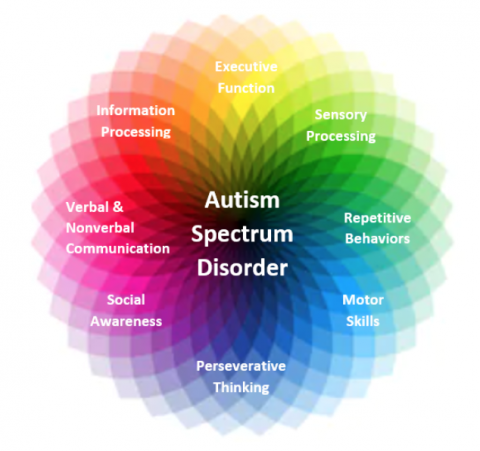Dealing With Usual Myths: What You Ought To Find Out About Autism Today
Dealing With Usual Myths: What You Ought To Find Out About Autism Today
Blog Article
Discovering Autism: Approaches for Effective Communication and Interaction
Effective interaction and interaction with individuals on the autism spectrum necessitate an extensive understanding of their distinct requirements and preferences. Strategies such as utilizing clear language, using visual supports, and promoting constant routines can dramatically improve engagement and minimize anxiety. Additionally, acknowledging the value of non-verbal hints and shared rate of interests leads the method for meaningful connections. The ins and outs of these methods reveal more considerations that merit exploration, particularly in just how they can be adapted to individual experiences and varied contexts. What might these adjustments resemble in method?
Understanding Autism Range Condition
Autism Range Problem (ASD) encompasses a series of neurodevelopmental problems characterized by challenges in social interaction, interaction, and recurring actions. The term "range" shows the diverse indications and varying levels of extent experienced by people with ASD. While some may show considerable problems, others might present high-functioning qualities, permitting greater freedom in day-to-day live.
The onset of ASD commonly happens in very early childhood years, with signs typically well-known by age 2. Very early indicators may consist of postponed speech growth, minimal eye contact, and problems in understanding social signs. Although the precise etiology of ASD remains unclear, research study recommends a mix of hereditary and environmental factors plays a critical role in its advancement.
People with ASD often possess distinct strengths, such as heightened attention to detail and phenomenal memory abilities. They may struggle with understanding abstract ideas and handling changes to routine - autism. Therefore, treatments and support tailored to private needs are vital for promoting interaction and social skills. Identifying the complexity of ASD is important for promoting awareness, approval, and efficient approaches that assist in significant interactions with people on the range.

Importance of Clear Communication
Efficient communication is vital for cultivating understanding and link, especially for individuals with Autism Range Problem (ASD) Clear interaction not just assists in social interactions but additionally boosts the individual's ability to reveal their ideas, emotions, and demands. For people with ASD, the subtleties of language can usually be testing; therefore, making use of simple and unambiguous language is essential.
Additionally, clear communication assists decrease disappointment and anxiousness that might emerge from misconceptions. When messages are conveyed in a straight and consistent manner, people with ASD are better furnished to interpret info properly, which can significantly boost their social interaction and engagement in various setups.
Developing routines and using aesthetic supports can additionally strengthen clear communication. These methods give individuals with foreseeable frameworks that assist comprehension and retention of info. In addition, proactively being and listening individual throughout interactions advertises a supportive atmosphere where people with ASD really feel valued and understood.
Eventually, focusing on clear interaction not only empowers individuals with ASD however additionally cultivates more significant links with their peers, caretakers, and the bigger community, paving the way for inclusive interactions and collective relationships. - autism
Non-Verbal Communication Methods
Communication prolongs past words, and for people with Autism Range Problem (ASD), non-verbal cues play a considerable function in communications. Non-verbal communication techniques can consist of faces, gestures, body movement, and eye contact, all of which function as crucial elements for communicating emotions and intents.
Understanding and interpreting these non-verbal signals can enhance interactions with people with ASD. As an example, a cozy smile or open pose can create a welcoming atmosphere, urging involvement. Using aesthetic help-- such as picture cards or icons-- can connect communication voids and assist convey messages more successfully.
It is likewise important to be conscious of personal room, as people with ASD may have various comfort degrees concerning proximity. Observing their responses to physical closeness can educate ideal modifications.

Creating Encouraging Atmospheres
Creating a helpful atmosphere is important for fostering favorable interactions and boosting the health of individuals with Autism Range Problem (ASD) Such settings can substantially decrease anxiety and produce a sense of security, allowing people to express themselves useful source more freely.
To attain this, it is necessary to take into consideration sensory sensitivities that people with ASD may experience. Changing the physical space to consist of soft lighting, minimal history noise, and comfortable seats can create a relaxing atmosphere. Furthermore, making use of constant like it regimens and clear aesthetic routines can aid individuals expect changes and reduce unpredictability, more advertising comfort.
Social areas need to be structured to minimize frustrating stimulations while offering chances for involvement in recommended activities. Helping with locations marked for quiet time can additionally offer as a refuge throughout moments of stress. Importantly, integrating components of selection empowers individuals, enabling them to work out agency in their atmosphere.

Motivating Social Communications
Promoting social communications among individuals with Autism Spectrum Problem (ASD) requires willful strategies that focus on convenience and engagement. Developing predictable regimens can assist reduce stress and anxiety, making social setups more approachable. Developing structured atmospheres with specified duties and roles enables people to involve without the overwhelming pressure of unstructured social characteristics.
Incorporating rate of interests and staminas right into social tasks can serve as a driver for communication. For instance, organizing team tasks around shared leisure activities or topics of fascination can assist in all-natural discussions and links. Additionally, using aesthetic assistances, such as pictorial schedules or social scripts, can aid in understanding social hints and assumptions.
Designing appropriate social behaviors is critical - autism. Peers and grownups need to show reliable interaction methods, consisting of active listening and turn-taking. Role-playing circumstances can additionally provide a risk-free space for people to exercise these abilities
Finally, promoting peer relationships via comprehensive techniques is essential. Urging comprehensive playdates or team trips can produce possibilities for socializing in a comfortable setting. By implementing these educators, caretakers and methods can dramatically boost social interactions for individuals with ASD, advertising their overall social development and wellness.
Conclusion
In final thought, efficient interaction and interaction approaches are essential for sustaining individuals with Autism Range Condition. Inevitably, these approaches empower people with autism to navigate social landscapes, advertising their general health and allowing the development of long lasting partnerships.
Efficient interaction and interaction with people on the autism spectrum require a detailed understanding of their one-of-a-kind requirements and preferences. Clear communication not just helps with social interactions however likewise improves the individual's ability to express their emotions, thoughts, and demands.Cultivating social communications amongst people with Autism Spectrum Problem (ASD) calls for willful approaches that focus on convenience and interaction. this post By executing these caregivers, instructors and methods can significantly enhance social communications for individuals with ASD, advertising their general social development and health.
In final thought, effective interaction and interaction strategies are crucial for supporting people with Autism Spectrum Problem.
Report this page